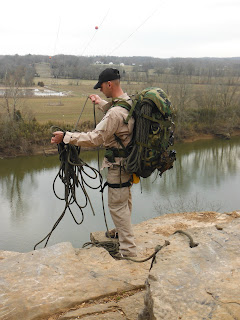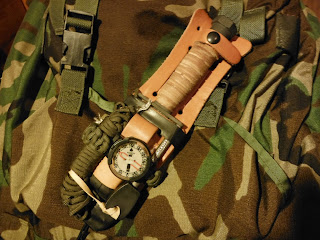 Kings Bluff has always been a great place to hang out for me. You are always bound to bump into a few interesting people, it has the most amazing view of the Cumberland Lake, and there is a mega-ton of climbing routes to try out for climbers. Needless to say, this trip has
been long overdue. This morning we were blessed with wonderful weather and great people
along the way and best of all I knew I was going to get some good rope time in along with some rigging to keep my practice up. I would say that this bluff is anywhere from 90 to 100 foot drop from where I am standing and while rappelling
down a 90 foot bluff is defiantly not an obstacle that a lot of people will
ever come across its is always fun to know how to do. So if you’re like me and prefer to take the road less traveled
then you are sure enough going to run into a spot where you can’t just get across unless you
jump, climb, or drop.
Kings Bluff has always been a great place to hang out for me. You are always bound to bump into a few interesting people, it has the most amazing view of the Cumberland Lake, and there is a mega-ton of climbing routes to try out for climbers. Needless to say, this trip has
been long overdue. This morning we were blessed with wonderful weather and great people
along the way and best of all I knew I was going to get some good rope time in along with some rigging to keep my practice up. I would say that this bluff is anywhere from 90 to 100 foot drop from where I am standing and while rappelling
down a 90 foot bluff is defiantly not an obstacle that a lot of people will
ever come across its is always fun to know how to do. So if you’re like me and prefer to take the road less traveled
then you are sure enough going to run into a spot where you can’t just get across unless you
jump, climb, or drop.
In the last two blogs I've already posted about my CFP-90 and how it has been really working out for me. This time I had it fitted with climbing/rappelling gear and surprisingly it held everything secure. No worries about losing anything on the way down because of all the ways you can strap gear to this ruck and lash it down.
 I
fitted the pack with 150 feet of rappel rope, three carabineers, a rescue
figure-8, and harness as well as my standard list for camping/bugging out equipment. I will have to do an update on this blog later to
get the actual weight of the pack with climbing gear but I probably added an extra 15 to 20 lbs. The side compression straps were perfect to
secure my rope to the sides. The midsection of the rope went under the top flap
portion of the ruck. The walk up to the jump off site was short, approximately ¼ miles
but allowed me to get a feel of how this would fair on a trek for longer
distance. Again this pack does an
amazing job of disturbing weight so there was little concern as being able to
go a few miles like this. Though I will say, unless you are certain that you would run into
deep canons, bringing 150 feet of rope was probably a little a bit of over kill. I could most likely get by with half of that
amount on a normal hike or better yet test out some other ideas. I've seen some YouTube videos with people
using 550 Para-cord to hold themselves from a tree and such; I’ll have to look
into that more on an extension of this blog. So, to be carrying 150 feet is
just not practical unless some proper recon has already been done and you know your going to need that much.
I
fitted the pack with 150 feet of rappel rope, three carabineers, a rescue
figure-8, and harness as well as my standard list for camping/bugging out equipment. I will have to do an update on this blog later to
get the actual weight of the pack with climbing gear but I probably added an extra 15 to 20 lbs. The side compression straps were perfect to
secure my rope to the sides. The midsection of the rope went under the top flap
portion of the ruck. The walk up to the jump off site was short, approximately ¼ miles
but allowed me to get a feel of how this would fair on a trek for longer
distance. Again this pack does an
amazing job of disturbing weight so there was little concern as being able to
go a few miles like this. Though I will say, unless you are certain that you would run into
deep canons, bringing 150 feet of rope was probably a little a bit of over kill. I could most likely get by with half of that
amount on a normal hike or better yet test out some other ideas. I've seen some YouTube videos with people
using 550 Para-cord to hold themselves from a tree and such; I’ll have to look
into that more on an extension of this blog. So, to be carrying 150 feet is
just not practical unless some proper recon has already been done and you know your going to need that much.
After all my knots are check and rechecked I’m
ready to look over the edge and feel my heart race again. This one of the reasons I love climbing so
much, it’s almost like the first time you kiss a girl or ask someone you really
like out for the first time. This is my
love and she gets me every time we meet.
I allow my weight to set into an L-position and start feeding rope
though my rescue-8 slowly. I slowly allow the rope to rest at the edge of
the bluff. Once I feel everything is
resting right, I kick off the rock with all enough force to send me flying through the air, 90
feet and dropping. My heart is racing a little more as I try to take everything
in, halfway down the side of the bluff there is a cut in where a tunnel or cave
is and I startled some climbers that were
curious about this so went inside the cave to explore (So many reasons to love the Bluff). There’s
nothing like a visit from some strange guy falling from above right? J
After a short bit of chat, I take a few more bounds off the bluff and land gracefully
to the ground.
As
a review of how this pack handled this event, I think I would be tempted to say
this pack was made for mountaineering because of how secure you can attach the
type of gear you would need in this terrain. I never once felt off balanced or out of
control. I don’t think I can express how awesome this
pack is! I've been trying to think of
things I would change about the pack and how it handled getting too and going
down, bounding through the air and the steep climb back up. was no problem at
all so I had to do
the rappel eight more
times and tried different ways to hook up and tie into the line. There was one
trip down where I allowed myself to land on my back (carefully of course) and
if you had a fatal hook up or the rope slipped from you somehow and landed on
your back, there would be a good chance that it would take a tremendous amount of the shock that could have otherwise ended much worse. Because there is no
external frame of metal or plastic that would act to injure you during a fall could land you on your spinal column.
I still have a deep water crossing to try out with this pack soon when the weather gets a little better as well as a 10 mile trek. I think I'm just trying to find more excuses to get out there and try new things because of the fun you can have. To all that do read my blog, I hope that you enjoy my stories and look forward to the next chance to explore the outdoors.
One
last thing before I close this, to everyone that was out there during this little
adventure 3/10/13 and reading my blog, I want to say you guys were great, CLIMB ON!






